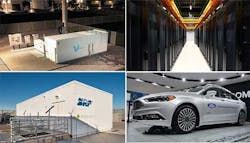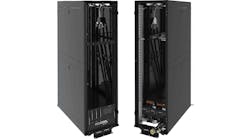Where exactly is the edge? It turns out that edge computing is evolving in tiers, with opportunities in regional data hubs, small cities at telecom towers and on devices. Think of it in terms of “edge, edgier and edgiest.”
These distinctions are still evolving, and are being closely tracked by data center providers, who are seeking to clarify their strategies for emerging opportunities in edge computing. Companies are deciding where they’re going to play, and when the business will arrive. Just as there are many edges, there are many ways to compete and capture business.
“Edge processing can happen at many tiers,” said Ron Batra, Senior Director of Technology Innovation at Equinix. “The cloud, the core and the edge data center must be coordinated. They cannot be islands.”
In many ways, edge computing is entering a phase similar to the “cloud muddle” of 2012-14, with dueling notions of how to define the technology. We believe that as with cloud computing, there will be many flavors of success with edge computing, writ both large and small.
But there is also risk, as edge models place a premium on getting the form factor right – matching the infrastructure to the business, and right-sizing them both.
The trend driving the edge computing model is the increased use of consumer mobile devices, especially consumption of video and virtual reality content and the growth of sensors as part of the Internet of Things. Artificial intelligence emerged as a major edge use case in 2017, while the 800-pound-gorilla of edge traffic – the autonomous car – looms on the horizon.
The visions of digital transformation are accompanied by a hard problem: how to pay for this new infrastructure, and the business models that will fund the distributed network.
Disruption Ahead, Bringing Opportunity and Risk
At Data Center Frontier, we spend the second half of 2017 having conversations with industry executives and analysts about edge computing and how it may develop. Executives say that like the the traditional colocation business, the market will be large enough to support a variety of strategies.
“Edge technology could be a device or a modular data center or a brick and mortar facility,” said Eddie Schutter, President of DCF Technologies. “Right now you have a pretty powerful edge device you carry around with you. Our dependence on these technologies will continue to grow.”
That means that data center infrastructure will slowly change, and become more distributed. A study from Synergy Research Group found that 60 percent of global colocation revenue comes from the 20 top markets. Data storage may be even more concentrated in the U.S., where the “Big Six” markets may represent as much as 70 percent of the market.
A shift to more distributed infrastructure, even if it occurs gradually, presents both opportunity and disruption. Data center, tower companies and mobile operators are deciding how best to build and monetize their edge computing infrastructure. Edge computing is evolving into four segments, which interact and overlap:
- Data centers in regional markets and smaller cities
- Micro data centers at telecom towers
- On-site IT enclosures and appliances to support IoT workloads (often referred to as the “fog” layer)
- End-user devices, including everything from smart speakers to drones and autonomous cars.
Understanding the trends at the fog and device level will be important in assessing demand. But for the data center industry, the opportunity is focused on the top two tiers, which include a wide range of options.
“A lot of people talk about edge as ‘I’m going to be as close to the tumbleweeds as I can,'” said Dave Leonard, Chief Data Center Officer at ViaWest. “The importance of the edge is that it can be anywhere, but the end-user experience drives where it is. You can’t just survive with one type of data center model. You’ll need to serve a variety of different users.”[clickToTweet tweet=”Dave Leonard of ViaWest: People talk about edge as ‘I’m going to be as close to the tumbleweeds as I can.’ You’ll need to serve a variety of users.” quote=”Dave Leonard of ViaWest: People talk about edge as ‘I’m going to be as close to the tumbleweeds as I can.’ You’ll need to serve a variety of users.”]
The appetite for mobile devices and new technology will transform the digital landscape. Some see this transition happening rapidly, with others predicting a more gradual shift. However edge computing evolves, data centers will be a key beneficiary.
“Position your data center for data and traffic volumes you’ve never seen before in history,” said Batra of Equinix. “The applications are going to get distributed. The Industrial Internet of Things is going to hit prime time in the next two years. As a data center company, we’ve got to understand that.
Ron Batra of Equinix: “Prepare for volumes of data you’ve never seen before.” (Photo: Rich Miller)
“My bias is that the edge will be for distribution,” he added during comments at the DCD Edge conference in Dallas. “Networks and interconnection will always be the key part of our business.”
Equinix is typical of many large data center companies in that its footprint is focused on large business markets where networks come together. Some market watchers estimate that as much as 70 percent of U.S. colocation business is focused on the six largest markets. But that is starting to change, and the first ripples have been seen in regional markets.
The Edge in Regional Markets
As data storage and traffic move out from the network core, the first wave of growth is seen in regional “second tier” markets. That was reflected in the headlines from 2017, as second-tier data centers gained new prominence in the industry’s growth and consolidation. Cologix, C7 Data Centers and FORTRUST were all acquired by larger providers, while two of the leading regional players, Peak 10 and ViaWest, joined forces through a merger.
Investors are clearly bullish on regional cities, and seek to build platforms that will thrive as these markets see stronger demand from both local businesses and content distribution. Many data center executives see these cities as the current front line of the shift towards the edge.
“Edge today is Tier III data centers in Tier 2 markets,” said AJ Byers, CEO of ROOT Data Center in Montreal. ‘”What we’re finding is that one or two locations in a metro area gets you what you need to be on the edge today. When it comes to more remote locations, we’re not really seeing the demand right now.”[clickToTweet tweet=”AJ Byers: Edge today is Tier III data centers in Tier 2 markets. We’re not seeing demand for more remote locations right now.” quote=”AJ Byers: Edge today is Tier III data centers in Tier 2 markets. We’re not seeing demand for more remote locations right now.”]
Some of the most active players in the regional market have been companies with experience in wireless infrastructure. That includes Digital Bridge, which has a long history in the wireless antenna and tower sector, and is pushing into data centers with its acquisitions of Vantage, DataBank and C7 Data Centers. Other rising data center players with wireless pedigrees include EdgeConneX and Stonepeak Infrastructure Partners, which acquired Cologix. Meanwhile, telecom tower companies are forging joint ventures with specialists in edge computing (more on this in a moment).
These companies all see opportunity in the the impending arrival of 5G wireless networks will be an enabler of new technologies that shift IT infrastructure outside of core markets, and require additional integration between data centers, telecom towers and antennas.
“The way the edge gets deployed is part data center infrastructure and part network infrastructure,” said Byers. “These two kind of have to work together.”
One company that’s been thinking about the growth of edge networks is TierPoint, a regional specialist with 40 data centers spread across the country, most in second-tier markets.
“We have primarily focused on the enterprise, but we’re interested in working with wireless carriers, and I think TierPoint is well-positioned to capture that business,” said Tony Rossabi, Chief Revenue Officer at TierPoint. “We’re morphing to look at what the next step is. We need to pay attention to micro data centers and how connectivity is going to shape that.”
A wildcard in the equation is how large telcos will leverage their existing infrastructure. That includes central offices, which are found in many smaller markets. New England telco Fairpoint Communications has converted several of its legacy central offices into micro data centers. What if AT&T and Verizon pursued a similar strategy? Central office retrofits can play a role in the distributed network, but don’t solve all the geographic challenges presented by edge applications.
The Edge at the Telecom Tower
The further you move out from the core of the network, the more important 5G wireless looms in the equation. 5G is the next-generation wireless standard being developed by the telecom industry. The arrival of 5G is expected to bring widespread disruption of American business, as low-latency connections enable new services.
That’s why telecom towers have been a focal point for the “edgier” component of a more distributed network. As more compute and storage is needed to handle new edge applications, why not layer it atop existing infrastructure?
“This really make sense,” said Caroline Chan, General Manager of the 5G Infrastructure at Intel. “As an industry, we’ve got to push this out there. It behooves us to try as many things as possible.”
An EdgeMicro modular micro data center, showing the cabinets inside. (Photo: EdgeMicro)
Data center startups are targeting this opportunity, including Vapor IO, EdgeMicro and DartPoints. These companies plan to deploy micro modular data centers at the base of cell towers and other key points in the existing wireless network. A critical element of their strategy is building relationships with the key players in this model – the wireless network providers investing in 5G infrastructure, and the tower REITs that control the real estate.
“What we see is a shift in power back toward the telcos,” said Cole Crawford, CEO of Vapor IO. That’s why Vapor is partnering with Crown Castle, which operates 40,000 tower sites across the United States. Crown Castle has taken an equity stake in Vapor IO as part of Project Volutus, an initiative to deploy micro data centers across the U.S. The first test site was recently launched in Chicago.
“We’ve always been a passive infrastructure player, but the world is changing,” said Alan Bock, Vice President, Corporate Development & Strategy at Crown Castle. “We realize we have to help solve for latency and data ingest, and our distribution infrastructure can help with that.
“We’re building the foundation to support diversification and 5G,” added Bock, who spoke at DCD Edge. “What we’re trying to do is lower the cost for telecom providers moving infrastructure to the edge. We are looking for ways to support the diversification of the wireless networks.”
A Gradual Progression Toward the Tower
These startups are staking an early position in a market that will develop over time, according to Hugh Carspecken, the CEO of DartPoints.
“You don’t really gain anything from being out at the tower today,” Carspecken said on a panel at the IMN Data Center Forum in Chicago. “The ecosystem is still being defined. You’ll see that ecosystem come together in 2019, laying the groundwork for the autonomous cars to come.
“You’re going to see a natural progression working its way out to smaller markets,” he added. “The key here is that you’re starting to see brand new applications and datasets.”[clickToTweet tweet=”Hugh Carspecken of DartPoints: The edge ecosystem is still being defined. You’ll see it come together in 2019, laying the groundwork for the autonomous cars to come.” quote=”Hugh Carspecken of DartPoints: The edge ecosystem is still being defined. You’ll see it come together in 2019, laying the groundwork for the autonomous cars to come.”]
Industry veteran Hunter Newby, CEO of Newby Ventures, agrees that different flavors of edge will be deployed gradually. “The key is figuring out the progression – the right location, and the right deployment size,” said Newby.
The tower initiatives are focused on micro modular data centers offering repeatable designs, rapid deployment and lights-out operation. Vapor IO is using 150 kW building blocks for its offering DartPoints is focusing on a 75 kW form factor for its enclosures, while EdgeMicro’s initial prototype features 48 kW of capacity.
“We deploy unmanned, automated sites at N+1 that are concurrently maintainable,” said Carspecken. “You’re going to see a little bit of everything at these sites. The redundancies we have historically built are going to change. Densities may be higher. There’s many different ways to do this.”
Making the Numbers Add Up
Panelists at DCD Edge contemplate the cost of edge computing. From left: Chris Crosby, CEO of Compass Datacenters; Eddie Schutter of DCFD Technologies; Ty Schmitt of Dell EMC; and George Slessman, CEO of IO. (Photo: Rich Miller)
Cost is a key factor in making these edge networks a reality. “The more you have to build, the more you have to pay for,” said Schutter. “How do you share that cost? With other providers? With the community? With consumers? Someone has to foot the bill.”
The industry has made progress in reducing the cost of data centers, according to George Slessman, who as CEO of IO has been a pioneer in deploying factory-built modular capacity. But more progress is needed to support the edge deployments being envisioned.
“The data center has to reduce the components inside it to deliver on the economics,” said Slessman. “We’re going to have to get to a point where data center capacity is sub-$2 million per megawatt to deploy.”
At all levels of edge computing, the financial success of early projects will help determine the shape of the projects to follow.
“The ultimate decision will be based on capital, because capital determines the course of this,” said Chris Crosby, the CEO of Compass Datacenters. “We build with hammers and saws and screwdrivers. It’s not that sexy anymore. If it’s a hammer used to build a skyscraper or a hammer used to build a house, it’s still a hammer.”
Standardization and repeatable designs are key to reducing these price points. Vapor IO’s Crawford says you also need to stay flexible to design for use cases that don’t yet exist.
“Some millennial is thinking of some low-latency technology that will take advantage of the post-5G network,” he said. “The edge augments the core. It’s not about provisioning for 40 sites, but for 40,000 sites.”
Explore the evolving world of edge computing further through Data Center Frontier’s special report series and ongoing coverage.






